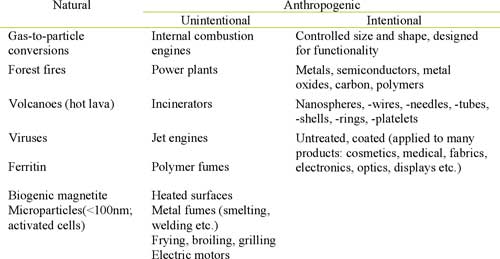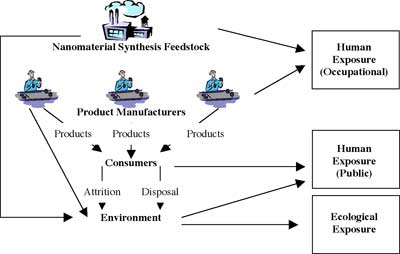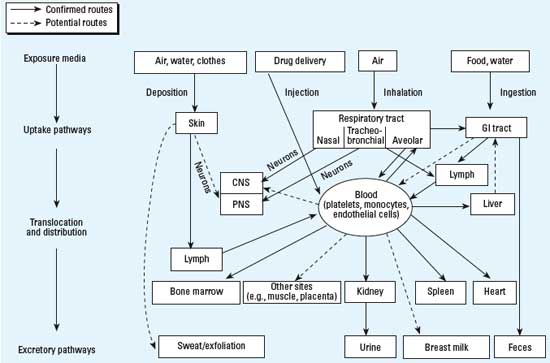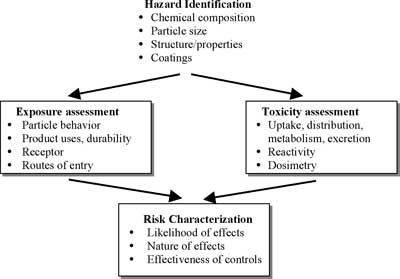| Posted: Feb 02, 2007 | |
Toxicology - from coal mines to nanotechnology |
|
| (Nanowerk Spotlight) The study of adverse health effects of nanosized particles is nothing new. Particle toxicology is a mature science, dealing with the exposure to airborne nanosized (or ultrafine) particles that either occur naturally or have increasingly been introduced through human activities or industrial products such as materials that include asbestos fibers and coal dust. Research on ultrafine particles has laid the foundation for the emerging field of nanotoxicology, with the goal of studying the biokinetics of engineered nanomaterials and their potential for causing adverse effects ("Nanotoxicology: An Emerging Discipline Evolving from Studies of Ultrafine Particles"). Most reports find that ultrafine particles are more toxic than equivalent larger-sized particles of a given material at similar doses per gram of body weight. | |
| While the release and production of nanoparticles during industrial and combustion processes and activities is mostly unintentional, the emergence of nanotechnological production processes introduces the intentional and controlled manufacture of nanoparticles. The latter can be further differentiated as either bulk nanoparticles in industry, e.g., carbon black or titanium dioxide, or so-called engineered nanoparticles, e.g., carbon nanotubes. | |
| Natural and Anthropogenic Sources of Nanoparticles (<100nm) | |
 |
|
| Potential for release and exposure to nanoscale substances ((Source: Oberdörster; Reproduced with permission from Environmental Health Perspectives) | |
| Given the prospects for nanotechnology, and the fact that products containing engineered nanoparticles have already been introduced to the marketplace, the increasing flow of new products will bring about the massive production of engineered nanoparticles. | |
| Despite all the scientific knowledge gained in the toxicology of particulate matter, because of the many variables involved, scientists still cannot accurately predict how nanomaterials will affect living organisms. What is clear, though, is that the biologic activity and biokinetics of nanoparticles are different from larger particles, and that they depend on many parameters. These parameters can modify cellular uptake, protein binding, translocation from portal of entry to target site, and the possibility of tissue injury ("Toxic Potential of Materials at the Nanolevel"). | |
| The complexity of the matter presents a daunting task | |
| Assessing the safety of engineered nanoparticles is a highly complex matter that goes beyond traditional toxicology. Engineered nanoparticles are not a uniform group of substances. The problem arises from the fact that particle size alone (which determines the surface area of a given mass of a substance) is not the only factor that determines the toxicological impact of a material and that makes nanoparticles of a given substance behave differently from the bulk form. | |
| Important from a toxicological point of view are the physiochemical properties that come with size and lead to certain biological reactivity. Size, together with differences in shape, surface structure, chemical composition (purity, crystallinity, electrical properties, etc.), solubility and biopersistence make for a large number of variables that need to be considered when assessing nanoparticles. On top of that, powders or liquids containing nanoparticles are almost never monodisperse but contain a range of particle sizes. This complicates experimental analysis as larger nanoparticles might have different properties than smaller ones. Also, nanoparticles show a tendency to aggregate and such aggregates often behave differently from individual nanoparticles. | |
| A recent article ("Nanohazards: Knowledge is our first defence") illustrates the problem: A study ("Photoinduced Conversion of Silver Nanospheres to Nanoprisms") describes how exposure to electromagnetic irradiation can permanently alter the shape of colloidal silver nanoparticles in solution. | |
| Subsequent research showed that the shape of silver nanoparticles is a decisive factor in determining the surface plasma resonances and electromagnetic field surrounding the particles. It is not yet clear how these photoinduced changes affect the bioreactivity of nanosilver. | |
| This leads Amanda Barnard, author of the article, to conclude: "If we cannot predict a priori how a material such as silver, which has been studied in one form or another for centuries, will respond to light, how can we make confident assumptions about how other nanomaterials will respond to other, seemingly benign, media such as water?" | |
| Different lifecycle stages mean different exposure routes | |
| A further complication is research that shows that some agents that seem harmless when administered orally or dermally are toxic to the lungs when inhaled ("Surface Reactivity in the Pathogenic Response to Particulatese"). That means the exposure route is an important factor to be considered during toxicological testing. | |
| Potential for release and exposure to nanoscale substances | |
 |
|
| (Source: Joyce S. Tsuji ("Research Strategies for Safety Evaluation of Nanomaterials, Part IV: Risk Assessment of Nanoparticles")) | |
| The potential exposure routes of a nanoparticle vary during its lifecycle. During the manufacture of a product, free engineered nanoparticles and carbon nanotubes might be present in the air during production, or might be released into the environment with waste materials or during production accidents. Product use could lead to exposure to engineered nanoparticles through the skin (cosmetic products), ingestion (food ingredients or packaging) or injection (medical procedures). After regular use, recycling or degradation of products might release engineered nanoparticles into the environment and lead to high concentrations in water, air or soil, which in turn could lead to exposure through skin, inhalation or ingestion. | |
| The potential for harm is real | |
| Studies in traditional particle toxicology mostly deal with airborne particles and results indicate that inhaled ultrafine particles (<100 nm diameter) can be harmful. Günter Oberdörster, a leading toxicology researcher at the University of Rochester, says that "studies have shown that airborne ultrafine particles can contribute to adverse health effects in the respiratory tract as well as in extrapulmonary organs." | |
 |
|
| While many uptake and translocation routes have been demonstrated, others are still hypothetical and need to be investigated. Largely unknown are translocation rates as well as accumulation and retention in critical target sites and their underlying mechanisms. These as well as potential adverse effects will be largely dependent on physicochemical characteristics of the surface and core of nanosized particles. Both qualitative and quantitative changes in nanosized particles' biokinetics in a diseased or compromised organism need also to be considered. (Reproduced with permission from Environmental Health Perspectives) | |
| One review points out that several studies suggest that engineered nanomaterials are not inherently benign and that they affect biological behaviors at the cellular, subcellular and protein level. | |
| ?Moreover? says Andre Nel, a professor at the Department of Medicine at UCLA and lead author of the review, "some nanoparticles readily travel through the body, deposit in target organs, penetrate cell membranes, lodge in mitochondria, and may trigger injury responses." | |
| "While the nanostructure-dependent properties of many engineered nanomaterials may place them in the category of potential hazards, the direct risk they present to human health will depend on the probability of exposures occurring, and the extent to which materials entering the body exhibit behavior associated with their nanostructure" says Oberd?rster. | |
| This is where systematic toxicological research comes in. Toxicology will have to play an important role in assessing the safety of new materials and applications arising from nanotechnology research. Current toxicological knowledge about engineered nanoparticles is extremely limited. A very few systematic studies have begun but none has delivered conclusive results yet. | |
| The Role of Nanotoxicology | |
| Toxicology is an interdisciplinary research field concerned with the study of the adverse effects of chemicals on living organisms. It applies knowledge, methods and techniques from such fields as chemistry, physics, material sciences, pharmacy, medicine and molecular biology. Toxicology established itself in the last 25-30 years as a testing science in the course of efforts of industrial nations to regulate toxic chemicals ("Toxicology as a nanoscience? ? Disciplinary identities reconsidered"). Particle toxicology, as a subdiscipline, developed in the context of lung disease arising from inhalation exposure to dust particles of workers in the mining industry. It later expanded to the area of air pollution. | |
| Most, if not all, toxicological studies on nanoparticles rely on current methods, practices and terminology as gained and applied in the analysis of micro- and ultrafine particles and mineral fibers. Together with recent studies on nanoparticles, this provides an initial basis for evaluating the primary issues in a risk assessment framework for nanomaterials: | |
 |
|
| (Source: Joyce S. Tsuji) | |
| Given the many parameters involved, nanotoxicology requires an interdisciplinary team approach, even more so than classical toxicology, in order to arrive at an appropriate risk assessment. | |
| As a still-maturing science, nanotoxicology will expand the boundaries of traditional toxicology from a testing and auxiliary science to a new discipline where toxicological knowledge of nanomaterials can be put to constructive use in therapeutics as well as the development of new and better biocompatible materials. | |
 By
Michael
Berger
– Michael is author of three books by the Royal Society of Chemistry:
Nano-Society: Pushing the Boundaries of Technology,
Nanotechnology: The Future is Tiny, and
Nanoengineering: The Skills and Tools Making Technology Invisible
Copyright ©
Nanowerk LLC
By
Michael
Berger
– Michael is author of three books by the Royal Society of Chemistry:
Nano-Society: Pushing the Boundaries of Technology,
Nanotechnology: The Future is Tiny, and
Nanoengineering: The Skills and Tools Making Technology Invisible
Copyright ©
Nanowerk LLC
|
Become a Spotlight guest author! Join our large and growing group of guest contributors. Have you just published a scientific paper or have other exciting developments to share with the nanotechnology community? Here is how to publish on nanowerk.com.
